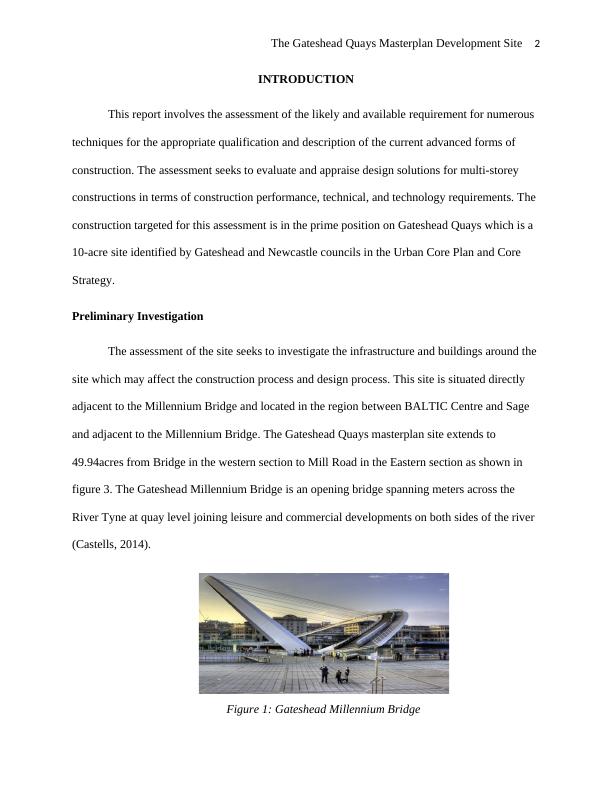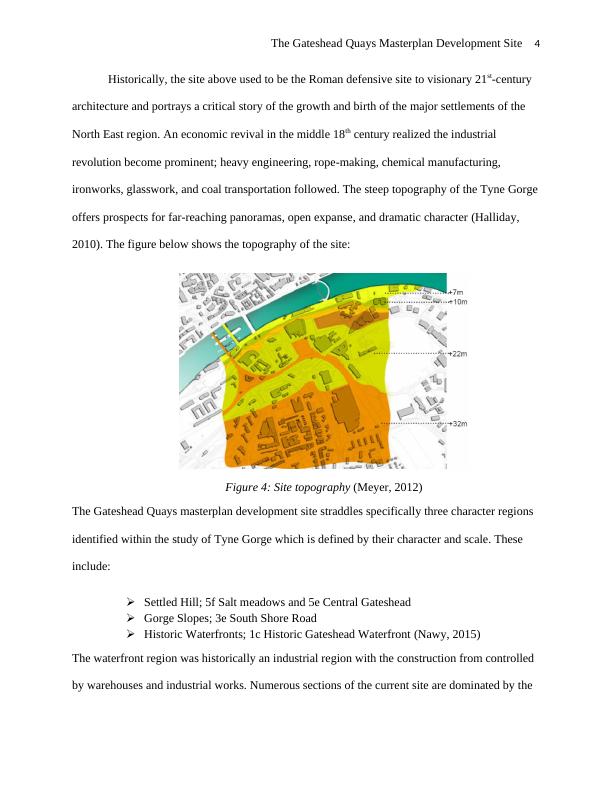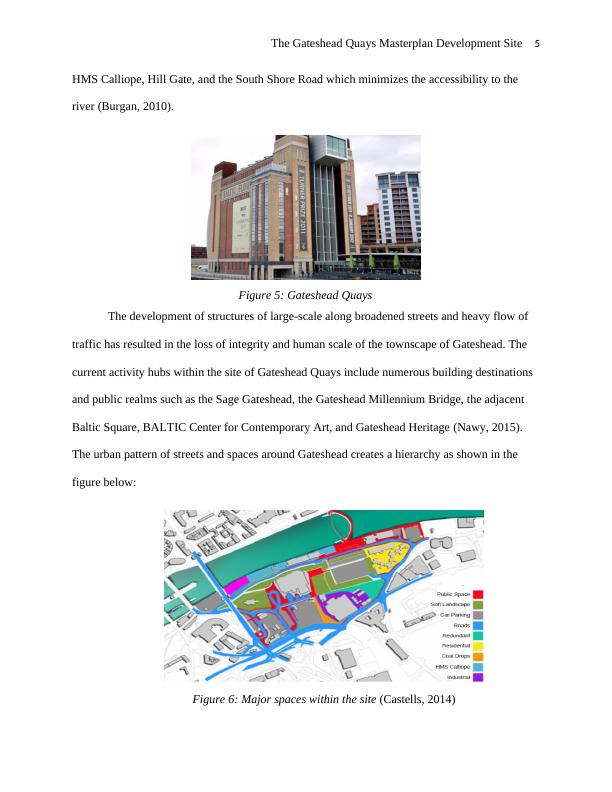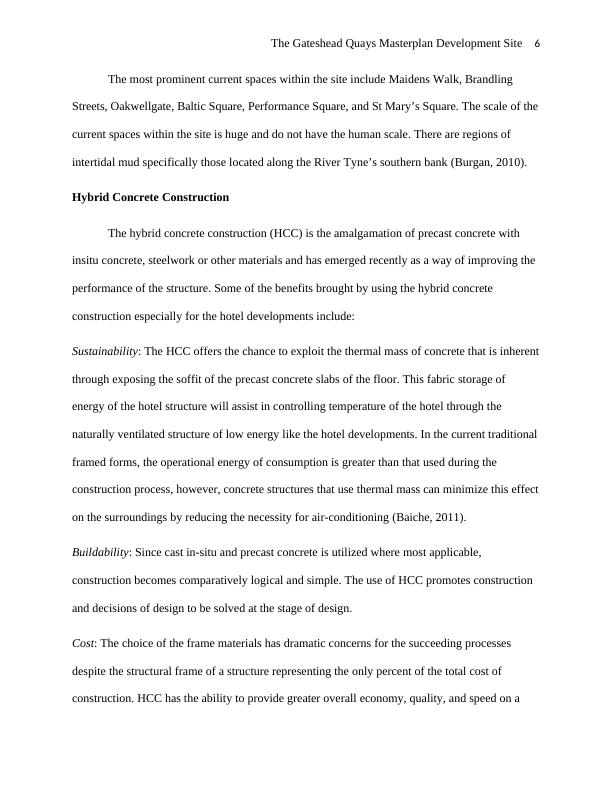Engineering and Environment Report Paper on Gateshead Quays Masterplan Development Site
Added on 2023-06-14
21 Pages3588 Words269 Views
The Gateshead Quays Masterplan Development Site 1
REPORT PAPER ON ENGINEERING AND ENVIRONMENT
A Report Paper on Construction By
Student’s Name
Name of the Professor
Institutional Affiliation
City/State
Year/Month/Day
REPORT PAPER ON ENGINEERING AND ENVIRONMENT
A Report Paper on Construction By
Student’s Name
Name of the Professor
Institutional Affiliation
City/State
Year/Month/Day

The Gateshead Quays Masterplan Development Site 2
INTRODUCTION
This report involves the assessment of the likely and available requirement for numerous
techniques for the appropriate qualification and description of the current advanced forms of
construction. The assessment seeks to evaluate and appraise design solutions for multi-storey
constructions in terms of construction performance, technical, and technology requirements. The
construction targeted for this assessment is in the prime position on Gateshead Quays which is a
10-acre site identified by Gateshead and Newcastle councils in the Urban Core Plan and Core
Strategy.
Preliminary Investigation
The assessment of the site seeks to investigate the infrastructure and buildings around the
site which may affect the construction process and design process. This site is situated directly
adjacent to the Millennium Bridge and located in the region between BALTIC Centre and Sage
and adjacent to the Millennium Bridge. The Gateshead Quays masterplan site extends to
49.94acres from Bridge in the western section to Mill Road in the Eastern section as shown in
figure 3. The Gateshead Millennium Bridge is an opening bridge spanning meters across the
River Tyne at quay level joining leisure and commercial developments on both sides of the river
(Castells, 2014).
Figure 1: Gateshead Millennium Bridge
INTRODUCTION
This report involves the assessment of the likely and available requirement for numerous
techniques for the appropriate qualification and description of the current advanced forms of
construction. The assessment seeks to evaluate and appraise design solutions for multi-storey
constructions in terms of construction performance, technical, and technology requirements. The
construction targeted for this assessment is in the prime position on Gateshead Quays which is a
10-acre site identified by Gateshead and Newcastle councils in the Urban Core Plan and Core
Strategy.
Preliminary Investigation
The assessment of the site seeks to investigate the infrastructure and buildings around the
site which may affect the construction process and design process. This site is situated directly
adjacent to the Millennium Bridge and located in the region between BALTIC Centre and Sage
and adjacent to the Millennium Bridge. The Gateshead Quays masterplan site extends to
49.94acres from Bridge in the western section to Mill Road in the Eastern section as shown in
figure 3. The Gateshead Millennium Bridge is an opening bridge spanning meters across the
River Tyne at quay level joining leisure and commercial developments on both sides of the river
(Castells, 2014).
Figure 1: Gateshead Millennium Bridge

The Gateshead Quays Masterplan Development Site 3
The construction process and design process of the buildings around the site has a
significant impact on the long-term sustainability of the project to be situated in the site
especially in the areas of thermal insulation standards, sound insulation standards, and space
provision. The constructions around the site will determine the design proposal since they will
directly affect the health and safety, productivity, and satisfaction with the design (Ofori, 2012).
The figures below show the location plan and relevant local construction images of the site:
Figure 2: Location plan of the Gateshead Quays Site (Burgan, 2010)
Figure 3: Constructions around the site (Deplazes, 2011)
The construction process and design process of the buildings around the site has a
significant impact on the long-term sustainability of the project to be situated in the site
especially in the areas of thermal insulation standards, sound insulation standards, and space
provision. The constructions around the site will determine the design proposal since they will
directly affect the health and safety, productivity, and satisfaction with the design (Ofori, 2012).
The figures below show the location plan and relevant local construction images of the site:
Figure 2: Location plan of the Gateshead Quays Site (Burgan, 2010)
Figure 3: Constructions around the site (Deplazes, 2011)

The Gateshead Quays Masterplan Development Site 4
Historically, the site above used to be the Roman defensive site to visionary 21st-century
architecture and portrays a critical story of the growth and birth of the major settlements of the
North East region. An economic revival in the middle 18th century realized the industrial
revolution become prominent; heavy engineering, rope-making, chemical manufacturing,
ironworks, glasswork, and coal transportation followed. The steep topography of the Tyne Gorge
offers prospects for far-reaching panoramas, open expanse, and dramatic character (Halliday,
2010). The figure below shows the topography of the site:
Figure 4: Site topography (Meyer, 2012)
The Gateshead Quays masterplan development site straddles specifically three character regions
identified within the study of Tyne Gorge which is defined by their character and scale. These
include:
Settled Hill; 5f Salt meadows and 5e Central Gateshead
Gorge Slopes; 3e South Shore Road
Historic Waterfronts; 1c Historic Gateshead Waterfront (Nawy, 2015)
The waterfront region was historically an industrial region with the construction from controlled
by warehouses and industrial works. Numerous sections of the current site are dominated by the
Historically, the site above used to be the Roman defensive site to visionary 21st-century
architecture and portrays a critical story of the growth and birth of the major settlements of the
North East region. An economic revival in the middle 18th century realized the industrial
revolution become prominent; heavy engineering, rope-making, chemical manufacturing,
ironworks, glasswork, and coal transportation followed. The steep topography of the Tyne Gorge
offers prospects for far-reaching panoramas, open expanse, and dramatic character (Halliday,
2010). The figure below shows the topography of the site:
Figure 4: Site topography (Meyer, 2012)
The Gateshead Quays masterplan development site straddles specifically three character regions
identified within the study of Tyne Gorge which is defined by their character and scale. These
include:
Settled Hill; 5f Salt meadows and 5e Central Gateshead
Gorge Slopes; 3e South Shore Road
Historic Waterfronts; 1c Historic Gateshead Waterfront (Nawy, 2015)
The waterfront region was historically an industrial region with the construction from controlled
by warehouses and industrial works. Numerous sections of the current site are dominated by the

The Gateshead Quays Masterplan Development Site 5
HMS Calliope, Hill Gate, and the South Shore Road which minimizes the accessibility to the
river (Burgan, 2010).
Figure 5: Gateshead Quays
The development of structures of large-scale along broadened streets and heavy flow of
traffic has resulted in the loss of integrity and human scale of the townscape of Gateshead. The
current activity hubs within the site of Gateshead Quays include numerous building destinations
and public realms such as the Sage Gateshead, the Gateshead Millennium Bridge, the adjacent
Baltic Square, BALTIC Center for Contemporary Art, and Gateshead Heritage (Nawy, 2015).
The urban pattern of streets and spaces around Gateshead creates a hierarchy as shown in the
figure below:
Figure 6: Major spaces within the site (Castells, 2014)
HMS Calliope, Hill Gate, and the South Shore Road which minimizes the accessibility to the
river (Burgan, 2010).
Figure 5: Gateshead Quays
The development of structures of large-scale along broadened streets and heavy flow of
traffic has resulted in the loss of integrity and human scale of the townscape of Gateshead. The
current activity hubs within the site of Gateshead Quays include numerous building destinations
and public realms such as the Sage Gateshead, the Gateshead Millennium Bridge, the adjacent
Baltic Square, BALTIC Center for Contemporary Art, and Gateshead Heritage (Nawy, 2015).
The urban pattern of streets and spaces around Gateshead creates a hierarchy as shown in the
figure below:
Figure 6: Major spaces within the site (Castells, 2014)

The Gateshead Quays Masterplan Development Site 6
The most prominent current spaces within the site include Maidens Walk, Brandling
Streets, Oakwellgate, Baltic Square, Performance Square, and St Mary’s Square. The scale of the
current spaces within the site is huge and do not have the human scale. There are regions of
intertidal mud specifically those located along the River Tyne’s southern bank (Burgan, 2010).
Hybrid Concrete Construction
The hybrid concrete construction (HCC) is the amalgamation of precast concrete with
insitu concrete, steelwork or other materials and has emerged recently as a way of improving the
performance of the structure. Some of the benefits brought by using the hybrid concrete
construction especially for the hotel developments include:
Sustainability: The HCC offers the chance to exploit the thermal mass of concrete that is inherent
through exposing the soffit of the precast concrete slabs of the floor. This fabric storage of
energy of the hotel structure will assist in controlling temperature of the hotel through the
naturally ventilated structure of low energy like the hotel developments. In the current traditional
framed forms, the operational energy of consumption is greater than that used during the
construction process, however, concrete structures that use thermal mass can minimize this effect
on the surroundings by reducing the necessity for air-conditioning (Baiche, 2011).
Buildability: Since cast in-situ and precast concrete is utilized where most applicable,
construction becomes comparatively logical and simple. The use of HCC promotes construction
and decisions of design to be solved at the stage of design.
Cost: The choice of the frame materials has dramatic concerns for the succeeding processes
despite the structural frame of a structure representing the only percent of the total cost of
construction. HCC has the ability to provide greater overall economy, quality, and speed on a
The most prominent current spaces within the site include Maidens Walk, Brandling
Streets, Oakwellgate, Baltic Square, Performance Square, and St Mary’s Square. The scale of the
current spaces within the site is huge and do not have the human scale. There are regions of
intertidal mud specifically those located along the River Tyne’s southern bank (Burgan, 2010).
Hybrid Concrete Construction
The hybrid concrete construction (HCC) is the amalgamation of precast concrete with
insitu concrete, steelwork or other materials and has emerged recently as a way of improving the
performance of the structure. Some of the benefits brought by using the hybrid concrete
construction especially for the hotel developments include:
Sustainability: The HCC offers the chance to exploit the thermal mass of concrete that is inherent
through exposing the soffit of the precast concrete slabs of the floor. This fabric storage of
energy of the hotel structure will assist in controlling temperature of the hotel through the
naturally ventilated structure of low energy like the hotel developments. In the current traditional
framed forms, the operational energy of consumption is greater than that used during the
construction process, however, concrete structures that use thermal mass can minimize this effect
on the surroundings by reducing the necessity for air-conditioning (Baiche, 2011).
Buildability: Since cast in-situ and precast concrete is utilized where most applicable,
construction becomes comparatively logical and simple. The use of HCC promotes construction
and decisions of design to be solved at the stage of design.
Cost: The choice of the frame materials has dramatic concerns for the succeeding processes
despite the structural frame of a structure representing the only percent of the total cost of
construction. HCC has the ability to provide greater overall economy, quality, and speed on a

End of preview
Want to access all the pages? Upload your documents or become a member.
